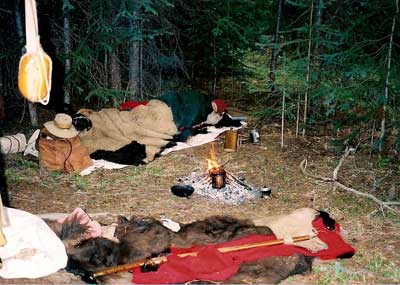Rocky Mountain Outfit — American Mountain Men (AMM) party of Colorado
Mountaineer Shelters: Introduction
Shelter is one of the essential elements of survival; it offers protection from the cold, the wet, the wind, and the wild things behind the darkness. This series of articles will look at the types of shelters used by the beaver hunters of the Rocky Mountains by using historical descriptions from those who were there.
One must remember that these were men constantly on the move using horses and mules for transportation. They were hauling the bare necessities along with traps and beaver plews from their catch. Only so much weight could be carried and it was better used to carry traps, powder, blankets, trade goods, &c. than large tents or other frivolous items that one sees at modern rendezvous.
The kind of shelters that could be used depended on the situation, location and terrain, as well as time of the year. Natural shelters such as under large trees, caves or rock overhangs, tarps and lean-tos, half dome or quarter spheres, wedge tents, Indian lodges, trapper built cabins, or nothing at all were the available choices.
The Bed

Mark Loader in bed after a rainy night.
The bed of a mountaineer is an article neither complex in its nature nor difficult in its adjustment. A single buffalo robe folded double and spread upon the ground, with a rock, or knoll, or some like substitute for a pillow, furnishes the sole base-work upon which the sleeper reclines, and, enveloped in an additional blanket or robe, contentedly enjoys his rest. — Rufus Sage 1
Regardless of whether a shelter is used or not, there is one thing in common, the bedding. Perhaps the most commonly used by the mountaineers was a blanket and epishemore 2 along with a saddle for a pillow.
An epishemore is a square cut piece of buffalo robe that was placed under a saddle during riding and then used in camp to sleep on 3. Blankets were made of wool since it is a good insulating material and can provide warmth even when wet. The most common size seen in the fur company inventory lists is 3 points. Many colors were available such as red, green, and blue, but white appears to be the most common, likely because it was cheaper to manufacture since there was no dyeing needed.
When sleeping on the ground it is important to have insulation between you and the ground to prevent excess loss of body heat. It is better to have more under you than on top. Epishemores, pine boughs, and dry grasses are some examples of materials used for insulation. In some cases raw animal skins were used instead of dressed ones. 4 Wrapping canvas or oilcloth around your bedding will also help to retain heat.
This was a severe cold night but I was comfortably situated with one Blanket and two Epishemores and plenty of dry wood to make a fire… — Osborne Russell 5
Here we can see how a trapper actually felt about his simple bedding. Russell goes on to mention that there was 3 feet of snow on the ground at the time. These were tough men, but keep in mind that they were in this environment all year long and were acclimated to the weather better than we are today. Even so, there are countless accounts of cold, wet, and miserable nights. They had to make do with what they had, in all seasons and weather, and sometimes it meant a long sleepless night huddled next to the fire.
We made a sort of shelter from the wind of pine branches and built a large fire of pitch Knots in front of it, so that we were burning on one side and freezing on the other alternately all night — Osborne Russell 6